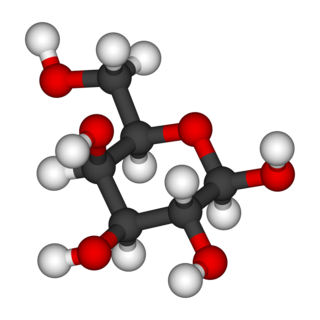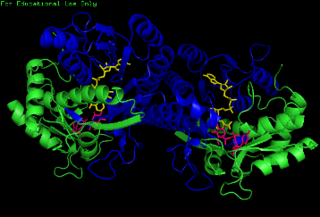Galactose 1-dehydrogenase may refer to:
Galactose 1-dehydrogenase may refer to:

Galactose, sometimes abbreviated Gal, is a monosaccharide sugar that is about as sweet as glucose, and about 65% as sweet as sucrose. It is an aldohexose and a C-4 epimer of glucose. A galactose molecule linked with a glucose molecule forms a lactose molecule.

Uridine (symbol U or Urd) is a glycosylated pyrimidine analog containing uracil attached to a ribose ring (or more specifically, a ribofuranose) via a β-N1-glycosidic bond. The analog is one of the five standard nucleosides which make up nucleic acids, the others being adenosine, thymidine, cytidine and guanosine. The five nucleosides are commonly abbreviated to their symbols, U, A, dT, C, and G, respectively. However, thymidine is more commonly written as 'dT' ('d' represents 'deoxy') as it contains a 2'-deoxyribofuranose moiety rather than the ribofuranose ring found in uridine. This is because thymidine is found in deoxyribonucleic acid (DNA) and usually not in ribonucleic acid (RNA). Conversely, uridine is found in RNA and not DNA. The remaining three nucleosides may be found in both RNA and DNA. In RNA, they would be represented as A, C and G whereas in DNA they would be represented as dA, dC and dG.
Carbohydrate metabolism is the whole of the biochemical processes responsible for the metabolic formation, breakdown, and interconversion of carbohydrates in living organisms.

Galactosemia is a rare genetic metabolic disorder that affects an individual's ability to metabolize the sugar galactose properly. Galactosemia follows an autosomal recessive mode of inheritance that confers a deficiency in an enzyme responsible for adequate galactose degradation.

Galactomannans are polysaccharides consisting of a mannose backbone with galactose side groups, more specifically, a (1-4)-linked beta-D-mannopyranose backbone with branchpoints from their 6-positions linked to alpha-D-galactose,.

In enzymology, aldose reductase is a cytosolic NADPH-dependent oxidoreductase that catalyzes the reduction of a variety of aldehydes and carbonyls, including monosaccharides. It is primarily known for catalyzing the reduction of glucose to sorbitol, the first step in polyol pathway of glucose metabolism.
In enzymology, a dTDP-galactose 6-dehydrogenase (EC 1.1.1.186) is an enzyme that catalyzes the chemical reaction
In enzymology, a galactitol 2-dehydrogenase (EC 1.1.1.16) is an enzyme that catalyzes the chemical reaction
In enzymology, a d-galactose 1-dehydrogenase (EC 1.1.1.48) is an enzyme that catalyzes the chemical reaction
In enzymology, a galactose 1-dehydrogenase (NADP+) (EC 1.1.1.120) is an enzyme that catalyzes the chemical reaction
In enzymology, a glucoside 3-dehydrogenase is an enzyme that catalyzes the chemical reaction

The enzyme UDP-glucose 4-epimerase, also known as UDP-galactose 4-epimerase or GALE, is a homodimeric epimerase found in bacterial, fungal, plant, and mammalian cells. This enzyme performs the final step in the Leloir pathway of galactose metabolism, catalyzing the reversible conversion of UDP-galactose to UDP-glucose. GALE tightly binds nicotinamide adenine dinucleotide (NAD+), a co-factor required for catalytic activity.

GDH/6PGL endoplasmic bifunctional protein is a protein that in humans is encoded by the H6PD gene.

UDP-galactose translocator is a protein that in humans is encoded by the SLC35A2 gene.

Inborn errors of carbohydrate metabolism are inborn error of metabolism that affect the catabolism and anabolism of carbohydrates.
The Beutler test, also known as the fluorescent spot test, is a screening test used to identify enzyme defects.
L-galactose 1-dehydrogenase (EC 1.1.1.316, L-GalDH, L-galactose dehydrogenase) is an enzyme with the systematic name L-galactose:NAD+ 1-oxidoreductase. This enzyme catalyses the following chemical reaction:
Alcohol dehydrogenase (nicotinoprotein) (EC 1.1.99.36, NDMA-dependent alcohol dehydrogenase, nicotinoprotein alcohol dehydrogenase, np-ADH, ethanol:N,N-dimethyl-4-nitrosoaniline oxidoreductase) is an enzyme with systematic name ethanol:acceptor oxidoreductase. This enzyme catalyses the following chemical reaction